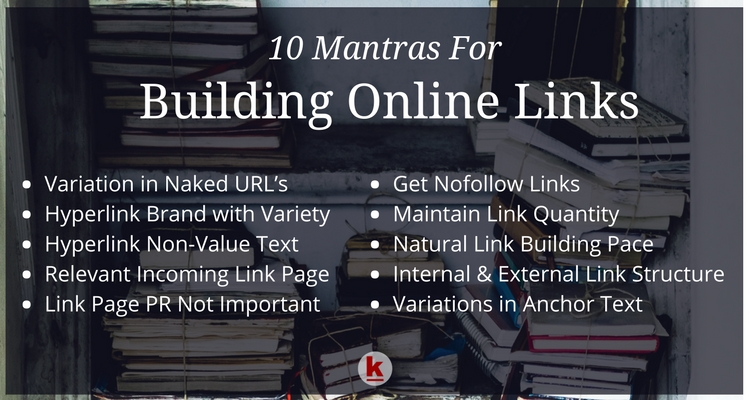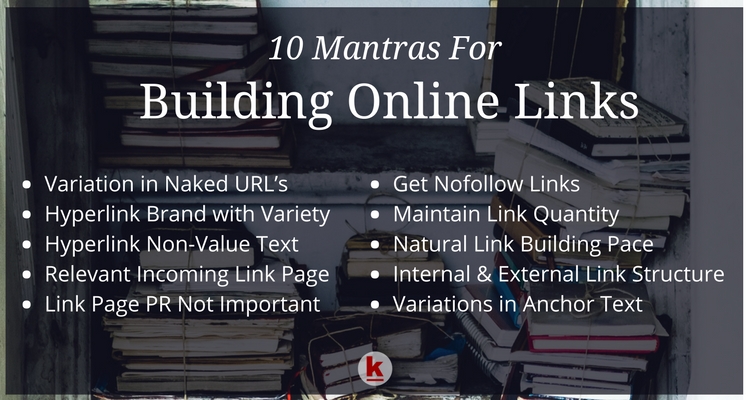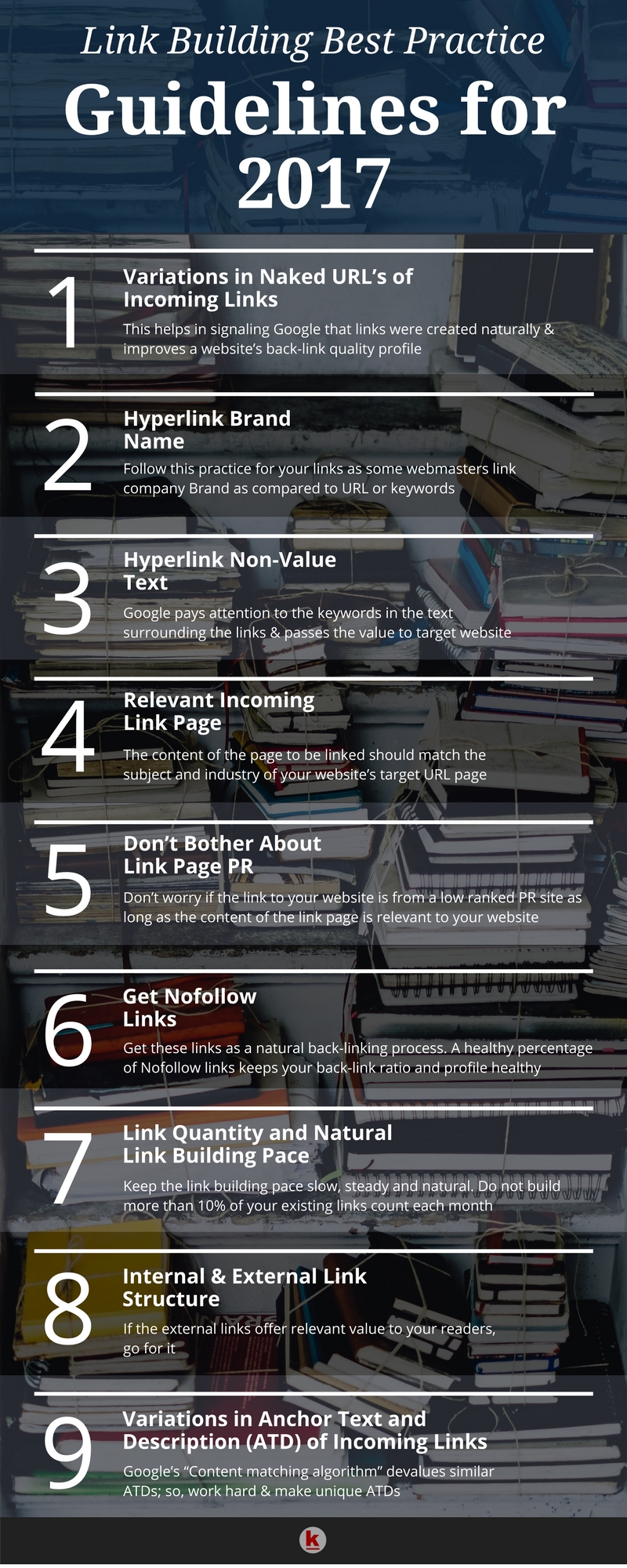
Link Building Best Practices for 2017

Post Google Penguin Update – Link Building Strategies
Ever since Google implemented Panda & Penguin algorithm update, several thousand websites have lost rankings on Google significantly. `There is a lot of confusion and speculation amongst SEO experts and webmasters on what kind of Link Building strategies in 2017 would be effective or safe and what one should follow.
Before we get down to the recommendations, here is a brief to clear the air about what Google Panda and Google Penguin algorithm updates were all about –
Google Panda Update:
Started from Feb 2011 to Jun 2017 (roughly over 20 updates), the Panda update acts more like a filter. It does not run live but calibrates the indexed websites in batch processing and the result is then relayed and synchronized with various Google Data Centers. Any corrective changes made to your website reflect in ranking only after your site is re-indexed by Google and after they re-run their next calibration computing.
As such, the impact on ranking may take from one to three months. It may be wise to be patient in expecting a ranking change in case you plan to update your website based on post-Panda advisories. Google Panda update focused on “content quality” of the website. It was NOT about checking the quality of the back-links. Google’s effort was to filter out low-quality content, poor user experience (noted user signals like high bounce rates), content over optimization, thin content (especially above the fold), copied / duplicate content, excessive Ads above the fold, content farms, scraped and spun content, poor usability. Parked domains were devalued, PageRank importance was downgraded.
The Panda update affects the entire (or section of the site) rather than individual pages.
Google Penguin Update:
Implemented between Apr 2012 and May 2017 (over a few versions), the Penguin update was focused on checking impact of low quality back-links, participating in link schemes, creating paid links, aggressive link exchanges, creating irrelevant outgoing or incoming links, webspam & blogspam back-links (from irrelevant, blog networks or bad sites), over-optimized exact match / keyword-rich / unnatural anchor text in incoming links, low quality article marketing (with embedded back-links), keyword stuffing in content, cloaking, sneaky redirects, doorway pages, creating doorway domains, keyword-rich internal navigation footer links across the site, creating purposeful duplicate content.
Google is in the process of discounting the value of bad links. Google may not necessarily penalize your site unless you have excessive bad links. In the same update, Google is rewarding the value of good incoming natural and brand links. Google has always taken signals of incoming links seriously. However, over a period of time, the creation of excessive unnatural links has devalued its algorithm and the quality of its results.
Post the Penguin update, be careful while creating back-links to your website so that you do not trigger the filter items of the Penguin updates. You need to immediately stop all kinds of links spam techniques you may have been using, particularly the ones listed above. The links you create should appear as natural as possible. In essence, if search engines did not exist, you would expect the links to be in the following (read ‘healthy’) format.
Follow these as your link building guidelines –
Have variations in the naked URLs of your incoming links:
Naked URLs are when the Anchor Text (hyperlink) in the incoming links show your website’s URL instead of the desired keywords. Having variations in naked URL is a strong signal to Google that the links were created as a natural process. This improves your back-link quality profile. For example, in the text (back-link) below, the URL of the website is hyperlinked and exposed, instead of hyperlinking the keywords to your URL–
“Search Engine Optimization Services:
Get expert SEO Services at affordable prices from redalkemi.com on monthly contracts. Guaranteed #1 page ranking on Google for selected relevant keywords for your business.“
If the links were built in a natural process, webmasters would typically link to your website URLs differently, like – redalkemi.com or https://redalkemi.com or https://redalkemi.com
Hyperlink Brand with Variety:
Several webmasters choose to hyperlink your company brand instead of URLs or keywords. Follow this practice in your links. The links would hyperlink RedAlkemi instead of the keyword or URL. The way the brand is written may also vary – RedAlkemi or Redalkemi or REDALKEMI or redalkemi. Difference in how the name is capitalized is important.
Hyperlink Non-Value Text:
Non-value (sometimes call Universal or Junk anchor text) is when the words used to hyperlink seem to pass on no real value to your website (like – Click here or visit this website or check out this website or here). Don’t be fooled. Google has increased the importance of LSI (Latent Semantic Indexing) of the relevant keywords in surrounding text of the link and passes on its value to the target website. You gain even if you do not have your exact target keywords in the anchor text. Keep the exact match of the keywords in anchor text of your incoming links to below 5% if you do choose to have them anyways.
Incoming Link Page Relevance:
Since Google has increased the importance of Latent Semantic Indexing (LSI) – page content relevance, it is important to have the content of the linking page match the subject and industry of your website’s target URL page. Link from an irrelevant industry is likely to do more harm than good for your website.
Link Page PR:
Since Google has devalued the impact of PR (PageRank) in their ranking algorithm, do not worry too much about getting links from high-PR pages, as long as the content of the link page is relevant to your website.
Link Quantity and Link Building Pace:
While it may seem that having a large number of back-links built quickly would benefit your website and beat the competition, it no longer works that way. Building back links work wonders but it does come with a few caveats. Newer websites rarely have the ‘natural’ traction to get hundreds of ‘natural’ back-links each month. A fast paced link building campaign would only arouse suspicion and invite investigation from Google. Keep the pace slow, steady and natural. Thumb rule would be – do not build more than 10 nos. or more than 10% of your existing links count each month, whichever is higher. If you have a 100 existing back-links, you can safely get about 10 new quality back-links each month. If you get a 100 back-links for your new website each month, you may raise a red flag.
On the other hand, a site like Amazon, which has over 100 Million back-links can get 2 million back-links each month without worrying.
Variations in Anchor Text and Description (ATD) of Incoming Links:
There was a time when you would make a set of Anchor Text and Description of your links campaign and ask your SEO Company to build a 100 links for each set. The content matching algorithm of Google would not only discount all such links but may also place a penalty on your website. What would a natural link building ATD look like? Probably all different with no exact duplicate match. Work harder on your ATD development, put some more thought, creativity and time to get good results.
Remember, the entire segment of the text should be keyword relevant instead of just focusing on the anchor text. You will still gain through LSI.
Nofollow Links:
What if you get links from a website, which place a <nofollow> tag on the link to your website eliminating any pass-through link benefit? Do not sweat. Still get those links. These links are still valuable as it is a natural back-linking process. A healthy percentage of Nofollow links keeps your back-links ratio and profile healthy.
Internal & External Link Structure:
Do unto others as you would have others do unto you. Keep your external linking (to other websites from your website) as relevant as you expect from others. If the external link offers relevant value to your readers, go for it. If you are planning to link to an irrelevant industry, drop it.
Link Exchange Scheme & Link Exchange Page:
If you have a links exchange page on your website, remove it immediately. If you are planning a link exchange campaign (even through emails), it will be of no use. Google directly discounts exchanged links.
Creating Cloaking, Sneaky Redirects, Doorway Pages & Doorway Domains:
Immediately remove any such techniques if you want to remain in Google’s index. Try and follow the above guidelines to keep your link building campaign and your link profile healthy. Google has sent out a few warnings in the past about bad back-links to the website owners through their Google Webmaster Tools account. Google later realized that removal of bad incoming links already created, may not be in direct control of the website owner. Following this analysis, they later retracted their warnings sent to the website owners. Instead, they offer webmasters the facility to disavow such links using their Google Webmaster Tools. Google’s link disavowal tool allows publishers to tell Google that they don’t want certain links from external sites to be considered as part of Google’s system of counting links to rank web sites.
It is important to note that Google has already started diluting or discounting the value of bad incoming links. At the same time, it is keeping a close watch at the ratio of the Good Vs Bad incoming links for your website. If your ratio improves, you do not need to kill yourself in trying to contact the webmasters of the bad linking sites to request them to remove your links. It is now time to focus on building better quality links going forward.
If you need help in your Link Building campaigns, which are Google Penguin compliant, please contact www.RedAlkemi.com

RedAlkemi was created out of the desire to deliver measurable online success to its customer base. The founders consider themselves the alchemists who work with passion (Red) to develop processes (Alkemi) that turn a basic digital presence to a measurable and successful one, therefore the name RedAlkemi.
Yes, it’s possible! Motivated by innovation, RedAlkemists believe they can help take your business to the next level. In an ever-evolving online environment, our vision is to keep “Shaping a holistic digital presence for businesses through innovative processes.”
FOLLOW US ON SOCIAL MEDIA





